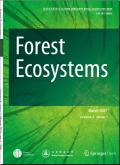Estimating area, standing carbon stock, and potential carbon stock of degraded forests in China
IF 4.4
1区 农林科学
Q1 FORESTRY
引用次数: 0
Abstract
With the rapid economic development and continuous expansion of human activities, forest degradation—characterized by reduced forest stock within the forest including declining carbon storage—poses significant threats to ecosystem stability. Understanding the current status of forest degradation and assessing potential carbon stocks in China are of strategic importance for making forest restoration efforts and enhancing carbon sequestration capacity. In this study, we used the national forest inventory data from 2009 to 2018 to develop a set of standard measures for assessing degraded forests across China, based on five key indicators: forest accumulation growth rate (FAGR), forest recruitment rate (FRR), tree species reduction rate (TSRR), forest canopy cover reduction rate (FCCRR), and forest disaster level (FDL). Additionally, we estimated standing carbon stock, potential carbon stock, and theoretical space to grow by developing a stand growth model, which accounts for stand density across different site classes, to evaluate the restoration potential of degraded forests. The results indicate that degraded forest area in China is 36.15 million hectares, accounting for 20.10% of a total forest area. Standing carbon stock and potential carbon stock of degraded forests in China are 23.93 million tons and 61.90 million tons, respectively. Overall, degraded forest varies significantly across different regions. The results highlight the important trade-offs among environmental factors, policy decisions, and forest conditions, providing a robust foundation for developing measures to enhance forest quality.
中国退化森林面积、立木碳储量及潜在碳储量估算
随着经济的快速发展和人类活动的不断扩大,森林退化对生态系统的稳定构成了重大威胁,其特征是森林内蓄积量减少,包括碳储量下降。了解中国森林退化现状,评估潜在碳储量,对开展森林恢复和提高固碳能力具有重要的战略意义。本研究利用2009 - 2018年全国森林资源清查数据,基于森林积累生长率(FAGR)、森林补充率(FRR)、树种减减率(TSRR)、林冠覆盖率减减率(FCCRR)和森林灾害水平(FDL) 5个关键指标,构建了一套评估中国退化森林的标准测度。此外,通过建立林分生长模型(考虑不同立地类型的林分密度)估算林分碳储量、潜在碳储量和理论生长空间,以评估退化森林的恢复潜力。结果表明,中国森林退化面积为3615万公顷,占森林总面积的20.10%。中国退化森林现有碳储量为2393万吨,潜在碳储量为6190万吨。总体而言,不同区域的森林退化程度差异很大。结果强调了环境因素、政策决定和森林条件之间的重要权衡,为制定提高森林质量的措施提供了坚实的基础。
本文章由计算机程序翻译,如有差异,请以英文原文为准。
求助全文
约1分钟内获得全文
求助全文
来源期刊

Forest Ecosystems
Environmental Science-Nature and Landscape Conservation
CiteScore
7.10
自引率
4.90%
发文量
1115
审稿时长
22 days
期刊介绍:
Forest Ecosystems is an open access, peer-reviewed journal publishing scientific communications from any discipline that can provide interesting contributions about the structure and dynamics of "natural" and "domesticated" forest ecosystems, and their services to people. The journal welcomes innovative science as well as application oriented work that will enhance understanding of woody plant communities. Very specific studies are welcome if they are part of a thematic series that provides some holistic perspective that is of general interest.
 求助内容:
求助内容: 应助结果提醒方式:
应助结果提醒方式:


